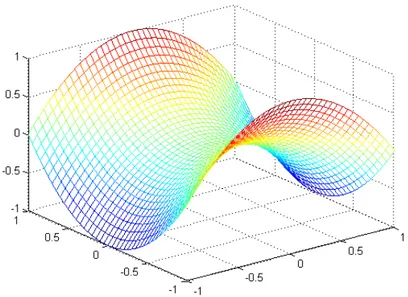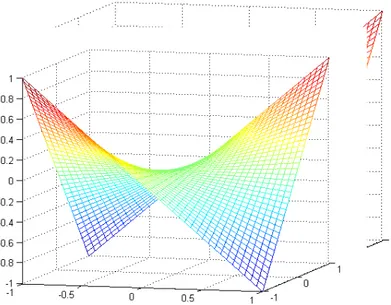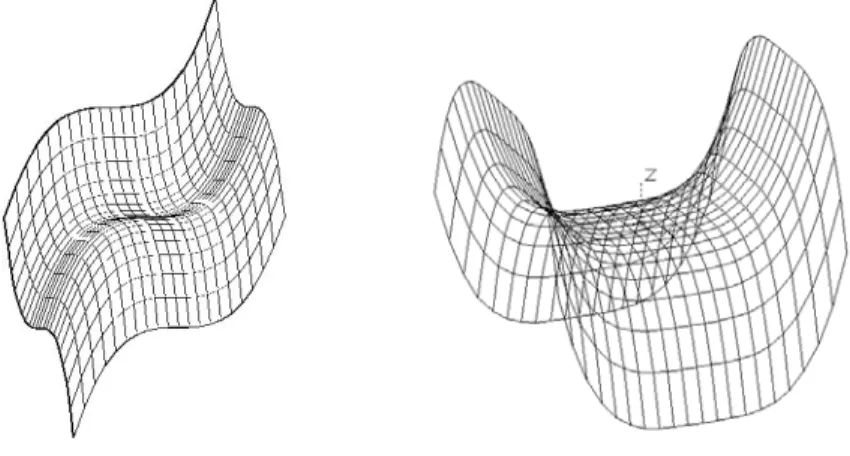See discussions, stats, and author profiles for this publication at: https://www.researchgate.net/publication/311308257
Working with Mathematical Tools for Generating Complex Surfaces A Case
Study
Conference Paper · January 2012
CITATIONS 0
READS 66
2 authors:
Some of the authors of this publication are also working on these related projects:
TUBITAK ProjectView project Yasemin Erkan Yazıcı
T.C. Istanbul Kultur University
24PUBLICATIONS 23CITATIONS
SEE PROFILE
Gokhan Yazici
T.C. Istanbul Kultur University
26PUBLICATIONS 38CITATIONS
SEE PROFILE
All content following this page was uploaded by Gokhan Yazici on 16 December 2016.
1
Working with Mathematical Tools for Generating
Complex Surfaces
A Case Study
Y. Erkan Yazici and G. Yazici
Istanbul Kultur University
Key words: Strength through Form, Hyperbolic Paraboloid Surfaces, Surface Generation, Parametric Design
Abstract: This paper presents the findings of a workshop conducted with the
undergraduate students of architecture at the Istanbul Kultur University within the “Form and Geometry”course. The main aim of the workshop was to inform the students on the ways of working with mathematical tools for generating complex surfaces. Matlab was chosen as the mathematical tool for this workshop due to its ease of plotting curved surfaces. After a brief introduction to the user interface and plotting features of Matlab, students were given the task of generating a hyperbolic paraboloid surface. Afterwards, the students were asked to experiment with their model and observe the effect of the change in the parameters on the model geometry. Finally, the students were shown how to export the generated surface to a DXF file and asked to import the surface model to Autocad. The workshop was concluded with a group discussion on the views of participating students on using mathematical tools together with CAD tools to generate complex surfaces and the difficulties they have experienced throughout the exercise.
1.
INTRODUCTION
1.1
Complex Surfaces and Architecture
Curved surfaces have been used in architecture since antiquity to achieve “strength through form”. In addition to structural efficiency and architectural expression, these forms can also be used for optimizing various factors such
2 DDSS 2012 as climate control and lighting. Although these surfaces do not need to be defined by exact mathematical equations for architectural expressions, many times these surfaces have to follow a strict mathematical equation in order to achieve strength and stability as well as other performance objectives (Allen and Zalewski,2010) (Bechtold, 2008) (Vollers, 2001).
Hyperboloids, helicoids and hyperbolic paraboloids are some examples of the mathematically defined curved surfaces used in architecture. Robert Hooke’s studies on the shape optimization of arches and the mathematical expression of the catenary curve in the late 1600’s was perhaps one of the most important stepping stones for the use of mathematically described curves in architecture (Evans,, 2000). The advances in the mathematics and mechanics as well as the introduction of new building materials in the industrial revolution era made it possible for engineers such as Shukhov and architects such as Gaudi to incorporate mathematically described surfaces
into their designs by the late 19th Century.
The Russian engineer, Shukhov used the shape of a hyperboloid in his designs of water storage and radio transmission towers in order to minimize the amount of building materials and labor. The Spanish architect Gaudi also experimented with hyperboloids, helicoids and hyperbolic paraboloids in his masterpiece La Sagrada Familia.
The use of mathematically defined curved surfaces on the design of thin reinforced concrete shells and tension net roofs covering large spans have
significantly increased by the second half of the 20th Century. The thin
reinforced concrete shells designed by Nervi, Torroja, Candela and Esquillan and the cable net roofs by Otto, Berger and Saarinen are excellent examples of how mathematically defined surfaces can be used to obtain efficient and beautiful works of architecture.
This paper reports a workshop conducted with the aim of informing the undergraduate students of architecture on the ways of working with mathematical tools in the geometric modelling of hyperbolic paraboloid surfaces.
1.2
Hyperbolic Paraboloid Surfaces
Hyperbolic paraboloid surfaces are ruled surfaces or surfaces obtained by sweeping a straight line which makes it possible to construct these surfaces by assembling straight members. Another attractive feature of hyperbolic surfaces is that these surfaces can be used to cover any base geometry without
the need of transition components such as pendentives (Velimirović et al.,
1998).
Perhaps the most important advantage of hyperbolic paraboloid roofs is that these surfaces develop the same tension and compression everywhere
under a uniform distributed load like its dead load or snow load which allows the structural material to be used to its greatest allowable capacity (Salvadori, 2002).
Hyperbolic parabolic surfaces or ‘hypars’ in short have been used in the
works of architecture since the end of the 19th Century. Earliest examples
include the works of the Russian engineer Shukhov and the Spanish architect Gaudi. The Mexican architect and engineer Felix Candela extensively used hyperbolic paraboloid surfaces in his designs of thin reinforced concrete shells. Hyperbolic paraboloid surfaces are also one of the most preferred forms used in the large cable net roofs (Forster and Mollaert, 2004).
Hyperbolic paraboloid surfaces can be described by equations (1) and (2). Desired curvatures and proportions of hyperbolic paraboloid surfaces can be obtained by adjusting the values of parameters a, b and c in equations (1) and (2). Examples of the hyperbolic paraboloid surfaces described by equations (1) and (2) are presented in Figures 1 and 2, respectively (Fomenko and Tuzhilin, 1991).
z/c = y2/b2-x2/a2 (1)
z = cxy (2)
4 DDSS 2012
Figure 2. Hyperbolic Paraboloid Surface (z=xy)
2.
CASE STUDY
A workshop was held within the scope of “Form and Geometry” course at the Department of Architecture of Istanbul Kultur University to investigate the potential of using mathematical tools in generating mathematically defined complex surfaces. A group of 16 students participated in the workshop, a majority of which were either in the third or fourth year of their undergraduate study.
The workshop began with an introductory lecture on the applications of mathematically defined surfaces in architecture. The first part of the lecture primarily focused on the concept of “strength through form” and the applications of hyperbolic paraboloid surfaces on the construction thin reinforced concrete shells and cable-net roofs. The second part of the lecture focused on the overview of the mathematical concepts used in generating curves and surfaces, the parametric equations used in the generation of hyperbolic paraboloids and the plotting features of Matlab which was the mathematical tool used in the workshop. Although, any spreadsheet program could be used for obtaining the coordinates of points on a mathematically defined curved surface, Matlab was chosen as the mathematical tool for this workshop due to its relatively simple user interface, advanced plotting
features, and the wide array of user developed scripts on the Mathworks Matlab Central web site.
Following the introductory lecture, students were given the task of experimenting with the parameters of the equations describing the surface of a hyperboloid paraboloid. In this stage of the study, students defined the boundaries and the density of the mesh as well as the parameters controlling the shape of the hyperbolic paraboloid in the Matlab programming environment.
After adjusting the shape of the hyperbolic paraboloid surface, the students were asked to construct a DXF model of the surface. DXF model format was chosen for this exercise due to the ease of exporting the model to other CAD packages. Students used the writeDXF script obtained from the Mathworks Matlab Central web site to convert the 3D mesh of the hyperbolic paraboloid surface into a DXF model (Siegle,1999). One disadvantage of using the DXF model format was the relatively large file sizes encountered when using fine meshes to describe the hypar surfaces.
In the final stage of the workshop, the students imported the DXF file of the hypar surface into the AutoCAD environment and experimented with the model. Examples of the generated hypar surfaces are presented in Figure 3. Students also modified the provided equations to obtain surfaces other than the hyperbolic paraboloid. Examples of these surfaces are presented in Figure 4. At the end of the workshop, students sent their DXF and DWG model files to the email address of the course.
The workshop was concluded with a group discussion on the views of participating students on using mathematical tools together with CAD tools to generate complex surfaces and the difficulties they have experienced throughout the exercise. An overview of the processes in the workshop is presented in Figure 5.
6 DDSS 2012
Figure 3. Examples of Hypar Surfaces Generated by Students
Figure 5. An Overview of the Processes in the Workshop
3.
CONCLUSIONS
Even with the vast advances in construction technology and computer aided design tools, curved surfaces are still considered challenging for students and practising architects alike. The main aim of this workshop was to inform the students on the ways of working with mathematical tools for generating complex surfaces. Although, the workshop primarily focused on the generation hyperbolic paraboloid surfaces, the approach outlined in the study can be used in generating a variety of other mathematically defined surfaces (Rovenski,2010). Another positive output of the workshop was that the process of experimenting with surface equations provided insight to the students on the basics of creative design exploration through parametric systems.
8 DDSS 2012
4.
REFERENCES
Allen, E., and Zalewski, W., 2010. Form and Forces: Designing Efficient, Expressive Structures, John Wiley&Sons, USA.
Bechthold, M., 2008. “Innovative Surface Structures: Technologies and Applications”, Taylor & Francis,USA.
Evans, R.,2000. The Projective Cast:Architecture and its Three Geometries, MIT Press, Cambridge,MA
Fomenko, A.T., and Tuzhilin, A.A., 1991. Elements of the Geometry and Topology of
Minimal Surfaces in Three-Dimensional Space, American Mathematical Society, USA.
Forster, B. and Mollaert, M., 2004. “European Design Guide for Tensile Surface
Structures”, Tensinet.
Rovenski, V., 2010. “Modeling of Curves and Surfaces with Matlab”, Springer, NY. Salvadori, M., 2002. Why Buildings Stand Up:The Strength of Architecture, W.W.Norton &
Company, NY.
Siegle, G.,1999. “writedxf.m” www.mathworks.com.
Velimirović, L., Radivojević, G., and Kostić, D., (1995). “Analysis of Hyperbolic
Paraboloids at Small Deformations”,Facta Universitatis, : Architecture and Civil
Engineering Vol.1, No 5, 1998 pp. 627 – 636.
Vollers, K.,2001. Twist and Build: Creating Non-Orthogonal Architecture, 010 Publishers, Rotterdam.
View publication stats View publication stats


